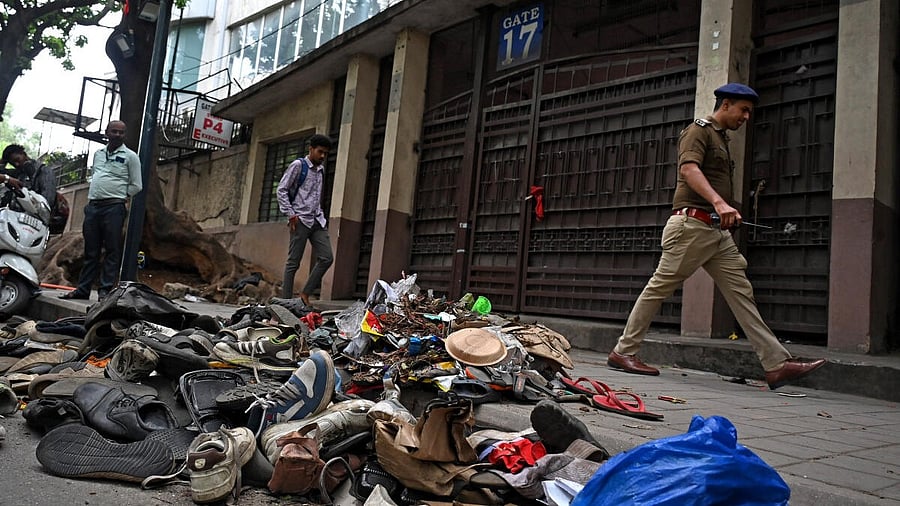
Remains littered the spot on Thursday where 11 people died in a tragic stampede, as thousands of fans had thronged to enter M Chinnaswamy Stadium in Bengaluru to take part in the celebrations of RCB's win in the Indian Premier League.
Credit: DH Photo/Pushkar V
Bengaluru: While the post-mortem reports of the 11 people who died in a stampede outside the Chinnaswamy Stadium on Wednesday, are awaited from hospitals, preliminary reports show their deaths were due to suffocation and traumatic asphyxia, a condition where severe blunt force to the chest causes compression of the thoracic region.
Of the total, six were taken to Bowring Hospital, four patients were declared ‘brought dead’ at VSH, while one patient died at Manipal Hospital Millers Road.
Doctors across hospitals explained how suffocation, apart from internal organ injuries, could occur in a stampede situation.
In a suffocating situation, people might find it difficult to breathe, leading to lack of oxygen reaching vital organs and causing the person to fall unconscious, said Dr Aruna C Ramesh, head of emergency medicine at a private hospital.
“When this happens, they fall down and are prone to physical injuries. This can occur at any crowd, even in a movie theatre, if a panic situation is created. This triggers panic, leading to disorderly movement, which further increases panic and chaos,” she explained.
Dr Ravindra Mehta, senior pulmonologist in the city, explained how multiple areas, besides the chest, are at risk in a stampede situation.
“Problems escalate due to fear and panic as the crowds swell, leading to a feeling of suffocation, which leads to higher chances of people stumbling and falling. Once on the ground, the abdomen, chest, head, and neck are all likely to be traumatised, which can have life-threatening consequences. Fear and sudden panic can lead to vasovagal syncope (fainting due to blood pressure dropping) and some people can have cardiac arrest as well,” he said.
A senior doctor from Victoria Hospital explained that internal organ injuries such as lacerations on the liver and spleen could complicate matters.
In a crowded area, people might feel suffocated and choking could occur, they could feel smothered” he said.
Survival tips during stampede-like situation
According to the doctors the best way to prevent such a situation is to avoid crowded areas. If that is not possible, this is their advice: Position both arms before your chest and crouch slightly to stave off anyone who is pushing. This also ensures space to breathe. Try to find an emptier spot, move with the people, and keep both feet on the ground. Try your best to find an emptier area and try not to fall down.